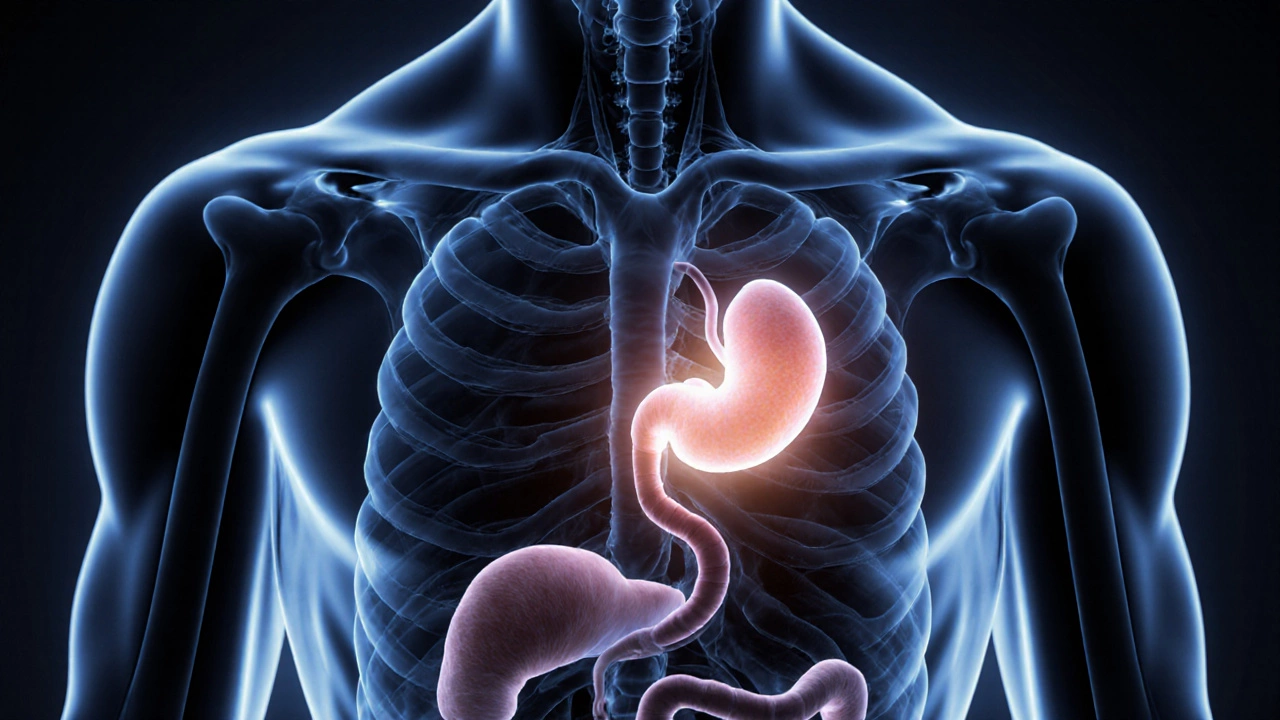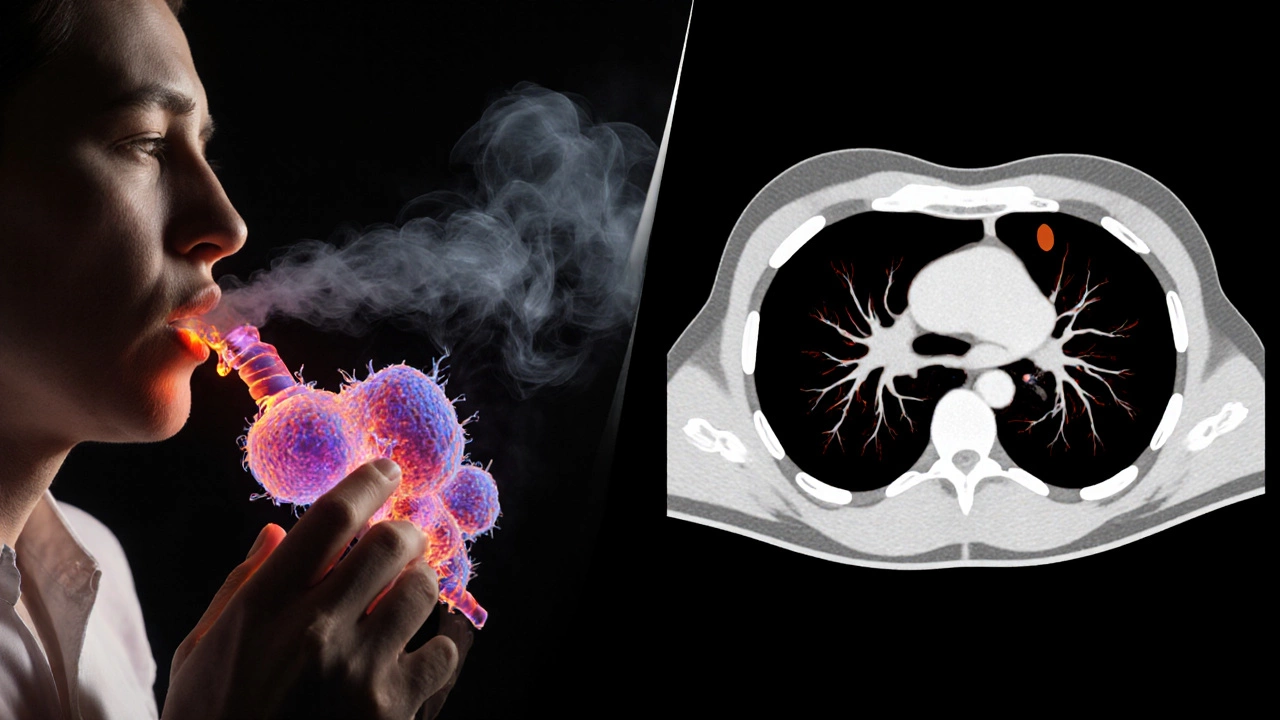
Cancer Risk Assessment Tool
Personal Cancer Risk Assessment
Your Risk Assessment
Pancreatic Cancer Risk
Lung Cancer Risk
Liver Cancer Risk
Esophageal Cancer Risk
Ovarian Cancer Risk
Recommended Next Steps
When someone says "the worst cancer," they’re not just talking about pain or fear. They’re talking about survival rates that barely move, treatments that barely work, and cancers that spread before you even know you have them. Some cancers are more dangerous not because they’re rare, but because they’re sneaky, fast, and stubborn. And right now, five types stand out as the deadliest based on real-world data from the American Cancer Society, WHO, and global cancer registries.
Pancreatic Cancer: The Silent Killer
Pancreatic cancer kills about 90% of people within five years of diagnosis. That’s not a guess-it’s the number from the National Cancer Institute. Why? Because the pancreas sits deep inside the body, hidden behind other organs. By the time symptoms like jaundice, stomach pain, or unexplained weight loss show up, the cancer has usually spread to the liver or nearby blood vessels. Surgery is the only real chance for survival, but only 15-20% of patients are even eligible. Even then, recurrence is common. There’s no screening test for the general public, no early warning sign you can easily spot. That’s why it’s called the silent killer.
Lung Cancer: The Leading Cause of Cancer Deaths
Lung cancer is the number one cancer killer worldwide. More people die from lung cancer each year than from breast, colon, and prostate cancer combined. The biggest reason? Late detection. Most cases are diagnosed at stage III or IV, when the tumor has already spread to lymph nodes or other organs. Smoking is the top cause, but non-smokers get it too-especially in places with high air pollution or radon exposure. Even with advances in targeted therapies and immunotherapy, the five-year survival rate for advanced lung cancer is still under 10%. Early detection through low-dose CT scans can cut death rates by 20%, but fewer than 5% of at-risk adults in the U.S. and India get screened regularly.
Liver Cancer: Rising Fast, Treated Too Late
Liver cancer is growing quickly in South Asia, including India, where hepatitis B and C are still widespread. Chronic infection, alcohol abuse, and fatty liver disease from poor diets are the main triggers. By the time symptoms like bloating, fatigue, or yellow skin appear, the liver is often already damaged beyond repair. Surgery or transplant is the only cure, but most patients aren’t candidates because the cancer is too advanced or the liver is too scarred. The five-year survival rate is just 18%. New drugs like lenvatinib and sorafenib help extend life, but they don’t cure. Prevention through vaccination (for hepatitis B) and reducing alcohol intake could save thousands.

Esophageal Cancer: A Slow Burn With Fast Consequences
Esophageal cancer is rare in the U.S. but common in parts of India, China, and Iran. It’s linked to smoking, heavy drinking, and eating very hot foods-something many people in South Asia do daily. The cancer starts in the lining of the esophagus and grows inward, making swallowing harder and harder. By the time people seek help, the tumor has often blocked the esophagus or spread to the lungs or stomach. Treatment usually means removing part of the esophagus, followed by chemo and radiation. But even with aggressive treatment, only about 20% of patients survive five years. There’s no screening program, no early test. It’s caught too late, too often.
Ovarian Cancer: The Whispering Disease
Ovarian cancer doesn’t scream. It whispers. Symptoms-bloating, feeling full fast, pelvic pain-are dismissed as indigestion, stress, or aging. By the time doctors find it, it’s often spread across the abdominal cavity. That’s why it’s called the "silent killer" of women. Only 1 in 4 cases are caught early. The five-year survival rate for late-stage ovarian cancer is 30%. Even with surgery and platinum-based chemo, tumors come back in most cases. There’s no reliable screening test like a Pap smear. CA-125 blood tests and ultrasounds aren’t accurate enough for the general population. Genetic testing for BRCA mutations helps high-risk women, but most don’t know they’re at risk until it’s too late.
Why These Cancers Are So Hard to Treat
These five cancers share three deadly traits:
- No early detection: No simple blood test, no routine scan, no symptom you can’t ignore. They hide until it’s too late.
- Fast spread: They invade nearby organs or travel through blood and lymph before you even feel sick.
- Resistance to treatment: Even when chemo or radiation works at first, the cancer cells evolve, adapt, and come back stronger.
Targeted therapies and immunotherapies have changed the game for some cancers-like melanoma and lung cancer-but they don’t work for everyone. And for pancreatic and ovarian cancer, they’ve barely moved the needle. Clinical trials are ongoing, but progress is slow.

What Can You Do?
You can’t control your genes. But you can control some risks.
- If you smoke-quit. It’s the #1 preventable cause of lung, esophageal, and pancreatic cancer.
- If you drink alcohol heavily-cut back. It’s linked to liver, esophageal, and breast cancer.
- If you have a family history of ovarian, breast, or colon cancer-get genetic counseling.
- If you have chronic hepatitis B or C-get treated. It can prevent liver cancer.
- If you’re over 50 and have a history of smoking-ask your doctor about a low-dose CT scan for lung cancer.
- Don’t ignore bloating, unexplained weight loss, or persistent pain. Push for answers.
Early detection isn’t magic. But for lung, liver, and colorectal cancers, it can mean the difference between living five years and living ten.
Hope Is Growing, But Slowly
Researchers are working on liquid biopsies-blood tests that can detect cancer DNA before tumors form. Early trials for pancreatic cancer show promise. AI is being trained to spot early signs on CT scans that even radiologists miss. Immunotherapy is being tested in combinations that might finally crack ovarian and liver cancers. But these are still in labs and small trials. They’re not standard care yet.
For now, the best weapon against the deadliest cancers is awareness. Knowing your body. Knowing your risks. Not waiting for pain to get bad. Not assuming symptoms are "just stress."
What is the number one deadliest cancer?
Lung cancer is the leading cause of cancer deaths worldwide. It kills more people each year than breast, colon, and prostate cancer combined. The main reason is late diagnosis-most cases are found after the cancer has spread. Smoking is the biggest risk factor, but air pollution and radon exposure also play a role.
Is pancreatic cancer always fatal?
Not always, but it’s extremely difficult to treat. Only about 1 in 5 people are diagnosed early enough for surgery, which is the only potential cure. Even after surgery, recurrence is common. The five-year survival rate is under 10% for advanced cases. New treatments like FOLFIRINOX chemo and targeted therapies are helping some patients live longer, but overall survival hasn’t improved much in decades.
Can ovarian cancer be detected early?
There’s no reliable screening test for the general public. CA-125 blood tests and ultrasounds are not accurate enough-they give too many false positives and miss early cancers. Symptoms like bloating, feeling full quickly, or pelvic pain are often mistaken for digestive issues. Women with a strong family history of breast or ovarian cancer should consider genetic testing for BRCA mutations and discuss preventive options with a specialist.
Why is liver cancer rising in India?
Liver cancer is rising in India due to high rates of hepatitis B and C infections, alcohol use, and non-alcoholic fatty liver disease from poor diets and sedentary lifestyles. Many people don’t know they have hepatitis until the liver is already damaged. Vaccination for hepatitis B and antiviral treatment for hepatitis C can prevent liver cancer, but access to testing and treatment remains limited in rural areas.
Are there any new treatments for these cancers?
Yes, but they’re not widely available yet. Liquid biopsies that detect cancer DNA in blood are being tested for early pancreatic and ovarian cancer. Immunotherapy combinations are showing promise in liver and lung cancer. For ovarian cancer, PARP inhibitors like olaparib have extended survival for women with BRCA mutations. These treatments are still mostly in clinical trials or reserved for specific genetic profiles. Widespread access is still years away.
Can lifestyle changes reduce the risk of these cancers?
Absolutely. Quitting smoking cuts lung and esophageal cancer risk by up to 50% within five years. Reducing alcohol intake lowers liver and esophageal cancer risk. Eating more vegetables, avoiding processed meats, and staying active can reduce pancreatic and colorectal cancer risk. Getting vaccinated for hepatitis B prevents liver cancer. These aren’t guarantees, but they’re the best tools we have right now.
What Comes Next?
If you’ve read this far, you’re already ahead of most people. You know that cancer isn’t one disease-it’s dozens, each with its own rules. The deadliest ones don’t always look the most aggressive. They’re the ones you don’t feel until it’s too late. The next step isn’t fear. It’s action. Talk to your doctor. Know your family history. Don’t ignore symptoms. And if you’re over 45, ask about screenings you might be missing. Survival isn’t about luck. It’s about timing-and awareness.

Write a comment